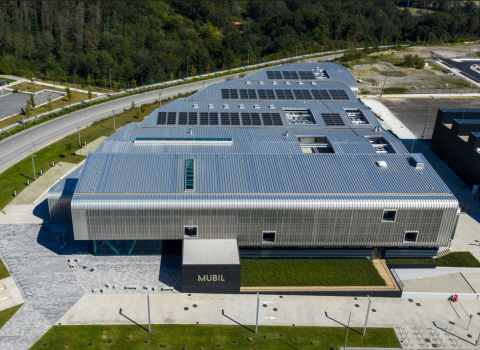The region of Lusatia has the expertise needed to create innovations and jobs in the hydrogen economy. The Saxon state government and the German federal government are confident of this. For that reason, they are jointly funding the newly established Fraunhofer Hydrogen Lab Görlitz (HLG) with over 42 million euros. With the HLG, the Fraunhofer-Gesellschaft is establishing an internationally unique research platform. From the end of 2022, novel technologies for generating, storing and using hydrogen along the entire hydrogen value chain can be developed and tested in Görlitz for fuel cells. This will strengthen the region in its structural transformation, as it will allow companies to settle there or develop further to benefit from the future market of hydrogen through technological leadership. The HLG will be located at the Siemens Energy Innovation Campus, where Saxony’s Minister President Michael Kretschmer and the Federal Minister for Economic Affairs Peter Altmaier visited the future construction site of the hydrogen test laboratory together with other guests today.
The HLG is jointly financed. The Free State of Saxony is funding the construction, installation of the plant technology and commissioning with 30.5 million euros, 90 percent of which is made up of federal financial aid. The federal government is also providing 10.5 million euros from the STARK program to promote projects that support the transformation process towards a sustainable economic structure in the coal regions. The Free State is providing a further 1.1 million euros for this purpose. In total, the funding for Fraunhofer amounts to 42.1 million euros.
Saxony’s Minister President Michael Kretschmer said after the visit: “The Hydrogen Lab is another flagship for Saxony as an innovation location. Görlitz can be an important player in hydrogen technology in Germany and Europe. This pioneering orientation not only creates jobs, but also strengthens the region. The Hydrogen Lab will make an important contribution to structural development. So I’m especially pleased that the federal government and the Free State of Saxony, as well as science and industry, have jointly launched the project.”
Federal Minister for Economic Affairs Peter Altmaier: “We promised the people that the coal phase-out would become an opportunity for the region. The Hydrogen Lab Görlitz shows very concretely how this can be achieved. The foundation for modernizing the economic structure and for tomorrow’s growth and prosperity is being laid here. And this is just one of numerous projects for the coal regions.”
Thomas Schmidt, Saxony’s State Minister for Regional Development, emphasized the HLG’s role as a model for structural transformation: “Hydrogen is the future source of energy! So, developing sustainable hydrogen technologies is the key to the success of a new energy policy. It’s not just structural development in Lusatia that stands to benefit from the Hydrogen Lab. With its establishment, Görlitz can become a model for successful structural transformation throughout Germany. Last but not least, Saxony’s companies will also benefit. It’s an opportunity for them to tap into new business fields and future markets.”
“Hydrogen technologies are a core element of the transformation of industry toward sustainable value creation — and central to the future viability of Germany as an industrial location,” said Prof. Reimund Neugebauer, President of the Fraunhofer-Gesellschaft, on the occasion of the handover of the grant. “International competition in this field, which is key to our technological sovereignty, is in full swing. To assume a leading role here, we need to lay the groundwork today with excellent research and targeted, efficient transfer of ideas and innovations to industry. The Fraunhofer Hydrogen Lab Görlitz will make a significant contribution to this and harness the enormous potential of the hydrogen economy for Germany, Europe and the Lusatia location.”
Research at the Fraunhofer Hydrogen Lab Görlitz (HLG)
The HLG is a networked research platform, integrated into the infrastructure of the new Innovation Campus Görlitz. The aim is to develop innovative solutions along the hydrogen value chain. The HLG benefits from the synergy effects of the research competencies of the Fraunhofer Institute for Machine Tools and Forming Technology IWU and the Fraunhofer Institute for Microstructure of Materials and Systems IMWS.
The initial research focus is on the generation and storage of hydrogen, supplemented by the use of hydrogen in mobile as well as stationary fuel cells, particularly for mobility and to supply neighborhoods and industrial sites. This mainly includes the evaluation of stacks and systems, microstructure analytics and diagnostics, digitalization, production processes, power electronics and certification.
In concrete terms, a digital and continuously growing data and knowledge space for SMEs is being created in the “ontoHy” research project. It includes tools, also known as ontologies, for presenting and transferring knowledge about application-oriented hydrogen technologies in digital form. As soon as the HLG goes into operation, the results of scientific analyses conducted there will flow into the project. The resulting competence platform will enable companies to test, develop, verify and integrate their products into the hydrogen cycle using technical, economic and ecological data. This project is also supported by the incorporation of the HLG into the regional hydrogen network “DurcH2atmen.”
Prof. Welf-Guntram Drossel, Executive Director of the Fraunhofer IWU, explained the opportunities that the establishment of the HLG will create for local companies and people, “Hydrogen isn’t just an alternative source of energy for the future. The production of innovative hydrogen system components offers huge potential for new value creation and high-quality jobs — not just in Lusatia. But it’s precisely to the companies there that the HLG is offering a unique opportunity to work at the forefront of a technology shift toward climate protection and sustainable competitiveness. The region’s economic structure will be different post coal, but its status as a major energy region will remain.”
Dr. Sylvia Schattauer, Deputy Institute Director of the Fraunhofer IMWS: “The HLG is another important building block for the market ramp-up of sustainable hydrogen technologies — after all, trust and acceptance through safety as well as cost-effectiveness through long service life and high reliability are crucial for this. Fraunhofer is making a unique offer by jointly orchestrating the hydrogen labs in Leuna, Görlitz and Bremerhaven. What holds true for Siemens Energy as the first industrial partner for the HLG is also possible for many other companies that have access to these platforms: They can benefit from our expertise and infrastructure to gain a technological edge.”
Dr. Jochen Eickholt, Member of the Executive Board of Siemens Energy: “The next five to ten years will determine whether we can sustainably transform our energy systems to master the energy transition. Green hydrogen will play a decisive role in this. The establishment of the Fraunhofer Hydrogen Lab Görlitz on our innovation campus is a very important milestone for the long-term further development of the site and for supporting structural transformation in Lusatia.”
The HLG in facts and figures
With its connected load of approximately 12 megawatts, the HLG will be the location for the development and testing of future-proof and sustainable hydrogen technologies on an industrial scale in Saxony. In close coordination with the Fraunhofer Hydrogen Labs in Leuna and Bremerhaven, it will actively contribute to achieving and sustainably securing climate neutrality and maintaining technological leadership in the field of hydrogen technologies over the next 15 years.
Construction work on the HLG is expected to begin in the fourth quarter of 2021. By the end of 2022, the HLG research platform is expected to begin research operations in stages. In the longer term, around 30 people will work at the HLG from full operational readiness in 2023, including 20 permanently employed scientists and ten additional regularly rotating employees from the field of education and training who will work on research projects.
This article was first published on June 17 by Fraunhofer.





 A unique international forum for public research organisations and companies to connect their external engagement with strategic interests around their R&D system.
A unique international forum for public research organisations and companies to connect their external engagement with strategic interests around their R&D system.